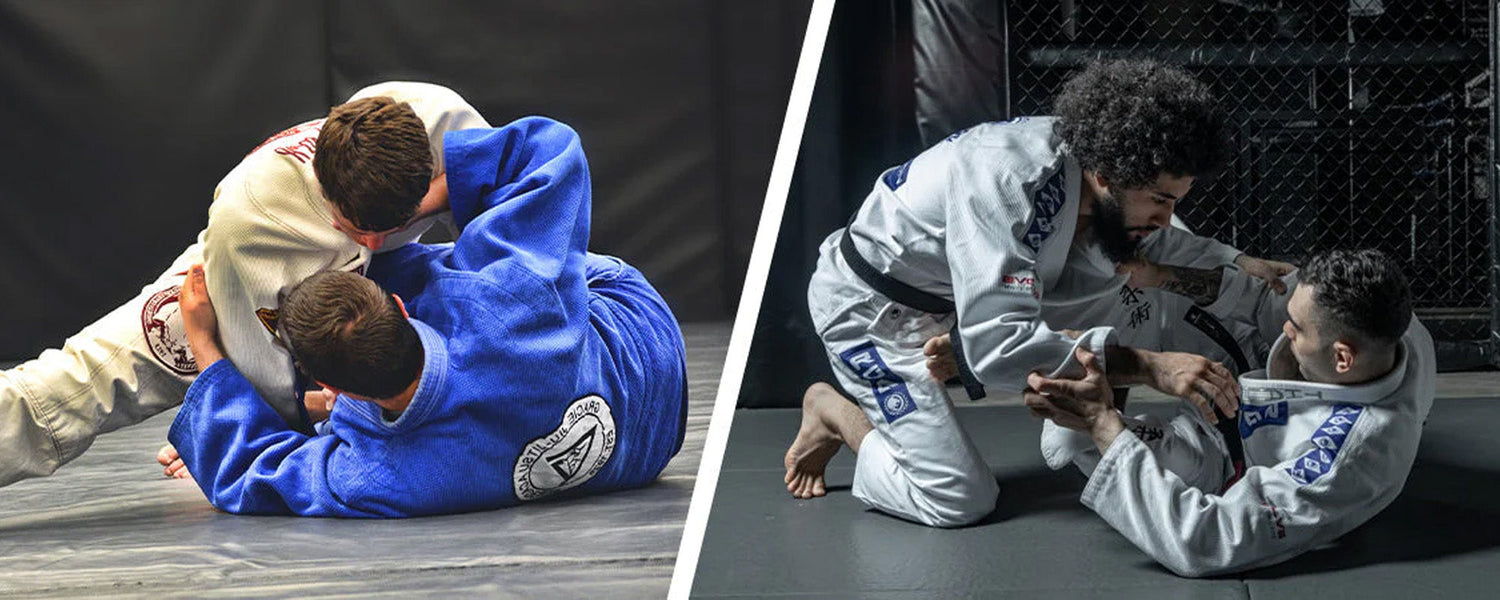Combat sports are watched and liked all over the World. Brazilian Jiu-Jitsu (BJJ) and Gracie Jiu-Jitsu (GJJ), both are types of grappling martial arts that originated from the same origin, Japanese Jiu-Jitsu. Despite having the same ancestral combat sports origin, both BJJ and GJJ have some differences as well.
BJJ is a sport in which competitors fight to win the match. BJJ competitors fight under some rules and regulations. BJJ also teaches self-defense but its first priority is to submit the opponent on the mat by following some restrictions and limitations.
In contrast to BJJ, GJJ is more about self-defense. GJJ competitors fight with a stranger of a stronger physique and bigger size. They are more focused on self-defense than winning a fight. Furthermore, they are not fighting according to rules and regulations, rather their ultimate goal is to get defense from some bad guy.
Table of content
1. History of Gracie Jiu-Jitsu
Gracie Jiu-Jitsu was first introduced by Carlos Gracie. Carlos Gracie was the son of Gastao Gracie and the grandson of George Gracie. Gastao Gracie was a business partner in a successful American Circus show in North Brazil.
He met with Mitsuyo Maeda, a Japanese person who has judo and Japanese Jiu-Jitsu skills. Mitsuyo Maeda was in Brazil to establish a Japanese community here. Gastao Gracie helped him with his political links. In return, Mitsuyo Maeda taught Judo and Japanese Jiu-Jitsu to Gastao’s son, Carlos Gracie.
Carlos Gracie loved Judo and wanted to learn combat sports. He took this opportunity as a golden chance to fulfill his dream. Carlos Gracie taught these skills to his brothers. At that time, Gracie's family was all involved to learn these skills.
Gracie's family did not just learn these fighting skills but also worked to add some more techniques to submit their opponent. All Gracie brothers went to various parts of Brazil and other countries to spread their newly originated combat sport, named Gracie Jiu-Jitsu.
2. History of Brazilian Jiu-Jitsu
In contrast to Gracie Jiu-Jitsu which originated in Brazil, BJJ arose in America. When the Gracie family started to spread their Jiu-Jitsu in America, Rorion Gracie was the manager of the Gracie Jiu-Jitsu.
Many other members of Gracie's family are not happy and satisfied with Rorion’s payments of money and allocation of opponents. At that time, Rickson Gracie was an undefeated champion and was undefeated by his brother in his various fights of Wrestling vs. Gracie Jiu-Jitsu in Japan.
In the championship of wrestling Vs. GJJ in which Rickson Gracie was expected to fight, Rorion Gracie invited Royce to fight instead of Rickson Gracie. Rickson was unhappy but he coached his brother to win the match. After winning that fight, both Royce Gracie and Rickson Gracie were not paid for the fight.
After this fight, various members of Gracie's family left Rorion and started their own academies in America. They enjoyed their freedom but not for a long time. Rorion was angry about this act and filed a lawsuit against his family members who opened their own academies using the name of GJJ. He filed a case of trade infringements against his family members.
So various members of the Gracie family are not allowed to use the term Gracie Jiu-Jitsu. Instead, they used the term Brazilian Jiu-Jitsu. In this way, Brazilian Jiu-Jitsu originated.
3. Differences between Brazilian Jiu-Jitsu and Gracie Jiu-Jitsu
Despite having the same ancestral point and same founder, GJJ and BJJ have some defined and clear differences in them. Brazilian Jiu-Jitsu is a modern type of Jiu-Jitsu that is more focused on competition rather than defense. Let's discuss some basic differences between BJJ and GJJ.
| Gracie Jiu-Jitsu | Brazilian Jiu-Jitsu |
|---|---|
| Main Objective | |
| Defense | Fight and Win the tournament |
| Techniques | |
|---|---|
| Basic techniques Realistic Techniques (can be used in a real-life experience) |
Advanced techniques which cannot be used in real-life situations (like armbar) |
| Targeted Person | |
|---|---|
| A unskill stranger of any size (too big or small sized) | A skillful and trained person (mostly same sized opponent) |
| Belt Rewarding System | |
|---|---|
| Belt upgraded when a practitioner has learned a number of techniques | Belt upgraded when a practitioner fought and defeat the person of same belt |
| Rule and Regulation | |
|---|---|
| Purpose of GJJ is to submit your opponent. Involve a few rules and regulations | BJJ has a lot of rules and regulations (white belt practitioners are prohibited to perform some techniques until they Blue Belt) |
3.1. Main Objective
The purpose of Gracie Jiu-Jitsu is to teach skills to students so they can easily defend themselves against street fights. GJJ teaches self-defense regardless of the age, gender, size, and fitness of the opponent in a real situation. Gracie Jiu-Jitsu is not just a defense art, it is also a lifestyle.
GJJ binds you to keep healthy. It does not just teach how to fight but also focuses on health issues. GJJ also ensures its fighters have a good diet and avoid unhealthy food like alcohol.
On the other hand, BJJ students are more focused on ground fighting and grappling. Self-defense shifted to a secondary purpose in BJJ. BJJ techniques are helpful in self-defense but are more focused on competitions and fights.
BJJ competitors are trained to fight under some rules and are more focused on submitting their opponent. They are not supposed to fight in a real situation with a person having zero or fewer fighting skills.
They are trained to fight with a person having the same skills of fighting as they have and most probably with competitors of the same weight.
3.2. Techniques
GJJ and BJJ are also different in their techniques and their application. GJJ is more focused on the techniques which are applicable in real-life fights. While BJJ contains various techniques which are advanced techniques and are not included in GJJ.
Techniques that are used in GJJ are designed according to the street fight situations. In GJJ, techniques must pass through a filter, named Helio and Carlos Gracie filters. Three elements of the filter are,
- Techniques must be energy efficient.
- Techniques must use natural movements which should be universally doable.
- Techniques must be applied in casual situations
In GJJ all techniques are allowed according to these rules. The main purpose is to defend yourself from some opponent. No matter which technique you are using.
In BJJ, all the techniques are more advanced which cannot be implemented in a casual fight. BJJ fighters just fight to win tournaments so they only implement restricted techniques. Techniques are according to physical attributes in BJJ. not everyone can apply these techniques.
Self-defense moved to a secondary priority in BJJ. In BJJ practitioners are not allowed to strike. While in GJJ, striking can be useful for self-defense.
For younger BJJ competitors, various techniques are prohibited. So their opponent is also forbidden to perform that technique. But in GJJ, the opponent is a stranger. So all the techniques are allowed to defend yourself.
Another fact about BJJ and GJJ is that all GJJ techniques can be used in BJJ. But all BJJ techniques cannot be used in GJJ. Because BJJ techniques are not applicable in real-life situations. For example, an armbar cannot be used in a street fight.
3.3. Targeted Person
In GJJ, the targeted opponent is a stranger. He might be of larger size and have more strength and minimum skills. Helio Gracie who is the Grand Master of GJJ was a small-sized person. So he introduced GJJ which teaches to fight with some stronger and bigger men using prestigious techniques.
On the other hand, BJJ offers a fight with a skillful person. In various BJJ matches, both fighters constitute the same weight (except in absolute weight matches). A fighter might be more experienced than others. But both fighters are restricted under some rules and regulations. A technique that cannot be used by one fighter is also prohibited by another one.
3.4. Belt Rewarding System
Both GJJ and BJJ involve ranking systems. In both Jiu-Jitsu systems, athletes are given belts of specific colors. Belts demonstrate ranks in Jiu-Jitsu. But there is a difference in their ranking system.
In GJJ, athletes are promoted to upper-grade belt level when they learn a specific number of techniques. For example, to get Blue Belt, fighters are expected to learn 36 techniques that can help them to defend themselves in street fights.
On the other hand, BJJ athletes would have to fight and submit to the opponent of their own belt level to get a promotion to the next belt. For example, if some fighter is on the Blue Belt level. He has to submit another Blue Belt fighter to upgrade to Purple Belt.
3.5. Rules and Regulations
Gracie Jiu-Jitsu and Brazilian Jiu-Jitsu also have different rules and regulations. This is not wrong to say that BJJ is more modulated and regulated than GJJ.
They cannot perform a technique that is prohibited. Their main goal is to win the fight by submitting another fighter. They are not allowed to harm opponents by crossing limitations.
In contrast, GJJ is a defense system that does not restrict its fighter to follow rules. GJJ practitioners are expected to fight for their defense. To defend themselves, they do not follow any rules. They have to implement any required technique to defend themselves.
4. Similarities Between BJJ and GJJ
Besides some differences, the basics of Gracie Jiu-Jitsu and Brazilian Jiu-Jitsu overlap. This is also a fact that both these fighting styles originated from the same ancestry. Let’s have an overview of the similarities between BJJ and GJJ.
4.1. Same Origin
BJJ and GJJ are two small outgrowths of a big branch. Both BJJ and GJJ are derived from the same origin. Carlos Gracie and Helio Gracie are the founders of both BJJ and GJJ. Helio Gracie is the Grand Master of both fighting styles. Furthermore, both BJJ and GJJ are derived from Japanese Jiu-Jitsu and Judo.
4.2. Belts System to Demonstrate Skills
In BJJ and GJJ, the ranks of athletes are demonstrated by the Belt system. Athletes are awarded belts of different colors which explain their rank, skills, and experience. The colors of belts for different ranks are similar in both BJJ and GJJ.
First of all, athletes are awarded Blue Belt after competing in the challenges in their white belt career. After Blue Belt, the sequence is Purple Belt, Brown Belt, Black Belt, Red, and Black Belt, Red and White Belt, and Coral Belt. Challenges to attain the next belt level just differ.

4.3. Basic Techniques
Basic techniques in both GJJ and BJJ are much alike. Like mounts, chokes, sweeps, and escapes. But BJJ includes various advanced techniques which are according to the physical attributes of some people. Not everyone can implement that technique.
GJJ includes self-defense techniques so everyone can implement those techniques. So we can say all the techniques which are used in GJJ are also used in BJJ. But various BJJ techniques are not allowed in GJJ.
5. Final Words
BJJ and GJJ both originated from the same origin, Japanese Jiu-Jitsu. So both have some overlapping aspects in them. But with the passage of time, BJJ and GJJ also have some considerable changes.
GJJ is more focused on self-defense while BJJ is more about submitting your opponent under some rules and regulations to win a tournament. BJJ shifted self-defense to the secondary level.
Photo Credit: @gracielouisville and @evolve-mma












Leave a comment
This site is protected by hCaptcha and the hCaptcha Privacy Policy and Terms of Service apply.